
views
- To remove sliding windows with clips, remove the sash stops and pop the removal clips open before you pull out the window.
- If your sliding window has a cord and pulley system, untie the cord before you remove the window.
- To remove sliding windows with tilt latches, slide the latches toward the center of the window, then disengage the sash from the track and lift it away.
Windows with Removal Clips
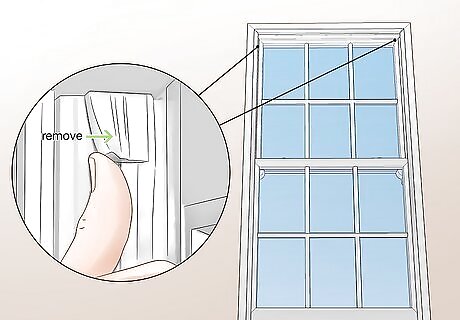
Unlock the window and pull out the sash stops from the top corners. The sash is the movable part of the window in the frame—what you typically think of as the window. Sash stops are small pieces of wood that are about 3 by 2 inches (7.6 cm × 5.1 cm) in size. They simply stop the window from opening too far, but they'll also stop you from removing the sash. Pull out the stops and set them aside in order to take out the window. Your window may have 1 moveable sash if it's single-hung or 2 moveable sashes if it's a double-hung window. If your sash stop has been painted, you might not be able to pull it out. Take a putty knife and carefully run it between the sash and window frame to break the painted seal. Some sliding windows don't have sash stops, so skip this step if yours doesn't. In some windows, you'll see a stick or dowel rod propped up to stop the window from moving—remove this and set it aside.
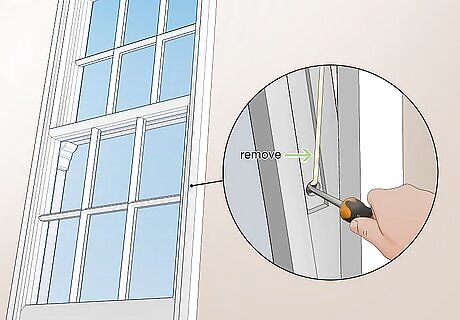
Remove the window’s cords if your window has them. If you’re removing an older window that opens with cords, pull the bottom sash out of the windowsill, so you can see the cords attached to its sides. Unhook the cords and tie them in a knot to prevent them from getting pulled into the pockets where the weights hang. Then, pry out the thin vertical strip of wood above the top sash, so you can pull the remaining window out. Be careful not to damage the wooden strips surrounding the window, since you'll have to reinstall them after you replace the sashes. Use caution if you're working with windows that have old paint on them—if the windows were painted before 1970, you may want to test them for lead and remove the contaminated paint as you replace the window.
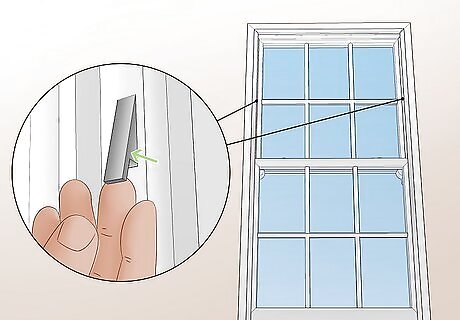
Pop out the tabs on both sides of the window jambs. The jambs are the vertical sides of the frame. Look near the top of the window for small metal tabs that are 1 inch (2.5 cm) high. Put your finger under each and pop them out. Sometimes, the tabs are painted to match the window jamb, so your window's tabs might be white instead of metallic. If you can't pop the tabs up with your fingers, put a flathead screwdriver under the tabs and work the tabs up, so they pop away from the window jambs. If you’re having trouble finding the removal clips, consult the owner’s manual that came with your windows when they were first installed. The manual should have a schematic showing the exact location of the clips.
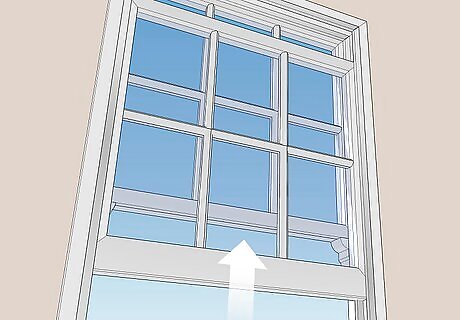
Lift up the bottom sash until it disengages from its tracks. Push the window up as far as it will go in the frame. Keep pulling until you hear a click as it slides over the removal tabs—this means the frame is off its tracks. Do not let go of the sash at this point or it will fall because it's no longer on its track.
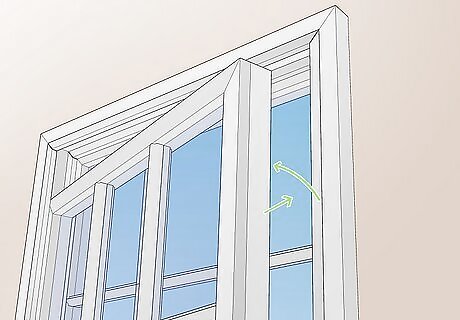
Pull the window out of the frame. Push the sash to the right or left side—it doesn't matter which. This just makes it easier to remove the sash. Then, pull the sash out of the frame from the side that you're not applying pressure to. Carefully set the window somewhere it won't get damaged. It may take some wiggling to pry the sash loose, but don't force it out. If the window seems stuck, check that you removed both of the cords, if your window has them, or ensure that the removal tabs are open. This method works for single-hung and double-hung windows. For single-hung windows, you'll only be able to remove the bottom sash. If you have double-hung windows, you can remove the bottom sash before repeating the steps to remove the top sash.
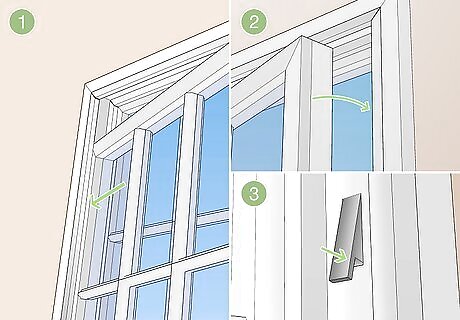
Push the sash back into the groove to reinstall the window. If you're done cleaning the window tracks or you're replacing the sash, hold the sash by both sides and raise it up to the top of the frame. Push 1 side into the track before easing the other side into the frame. Then, slide the sash down and push the removal clips back in place. If your window had cords that you removed, reinstall the cords to the sides of the sash before you push it back in place. For most windows, you simply push the cords into a slot on the side of the sash. For extra stability, you can also screw the cords to the side of the sash after you've pushed them into place.
Windows with Tilt Latches
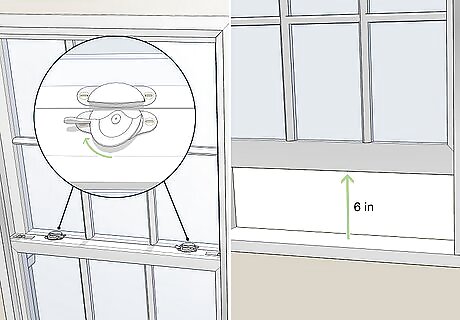
Unlock the window and slide the vertical sash up. The sash is the movable part of the window. Some windows have 2 locks while others have 1—be sure to unlock both if your window has 2. Then, raise the sash at least 6 inches (15 cm) from the bottom of the windowsill to give you room to maneuver the window. This method works if your window has 1 moveable sash (a single-hung window) or 2 moveable sashes (a double-hung window). If you're removing a vertical window that's high up and you have trouble reaching the top of the sash once you open it, stand on a small step stool.

Slide both tilt latches toward the center of the window. Find the tilt latches on the top of the sash—they look like 1 in (2.5 cm) long narrow buttons that slide to hold the sash in place. Use your index fingers to slide each of the latches toward each other simultaneously to disengage the sliding window from its track.
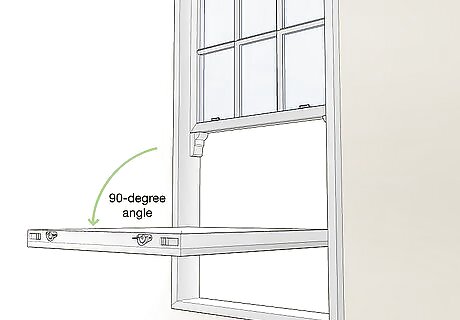
Keep holding the latches and bring the window towards you. Gently pull on the sash to tilt it inward until the sash is at a 90-degree angle. Ensure that the glass won't hit anything when you lower it toward you. Then, you can release the tilt latches. Some windows have long thin rods called restrictors that extend to keep the tilted window open. If your window has metal restrictors that prevent you from opening the window to 90-degrees, use a Philip's head screwdriver to unscrew the restrictors and remove them. Keep holding the sash, so it doesn't drop when you remove the restrictors.

Raise 1 side of the sash to pull it out of the window to remove it. Hold both sides of the sash and pull up on just 1 side to disengage it from the track. Then, remove the sash and set it somewhere it won't get damaged. This process works for double-hung windows, too. So, if you want to remove the top sash from the frame, slide the top sash down and repeat the process.
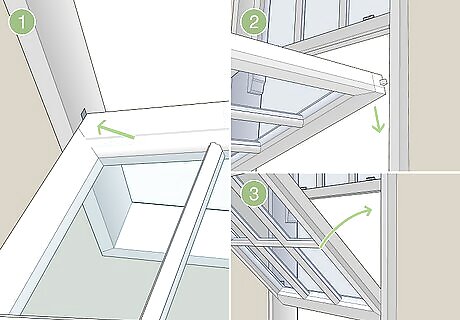
Reinstall the sash if you're replacing it. Once you're done cleaning the window or you've gotten out the new sash, grip it by both sides so the exterior side of the sash faces up. Then, tilt 1 side up a little to get it back into the window track before you insert the other side into the track. Tilt the sash up and the tilt latches will spring into place. If your window has restrictors, extend them and screw them back into place after you've put the sash back in the frame. If you're replacing both sashes on a double hung window, start with the top sash and place it in the outer track of the window. Then, reinstall the bottom sash on the inner track.















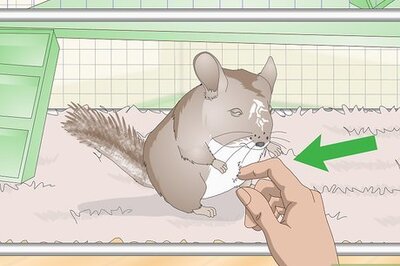


Comments
0 comment